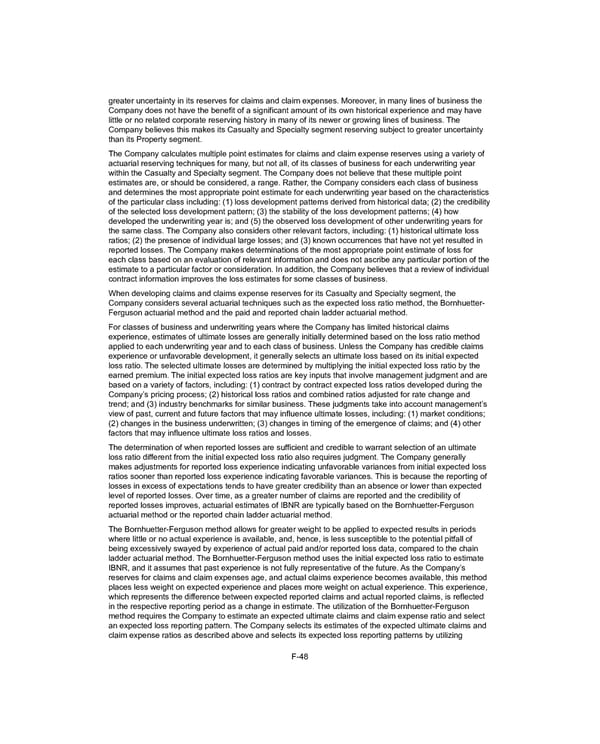greater uncertainty in its reserves for claims and claim expenses. Moreover, in many lines of business the Company does not have the benefit of a significant amount of its own historical experience and may have little or no related corporate reserving history in many of its newer or growing lines of business. The Company believes this makes its Casualty and Specialty segment reserving subject to greater uncertainty than its Property segment. The Company calculates multiple point estimates for claims and claim expense reserves using a variety of actuarial reserving techniques for many, but not all, of its classes of business for each underwriting year within the Casualty and Specialty segment. The Company does not believe that these multiple point estimates are, or should be considered, a range. Rather, the Company considers each class of business and determines the most appropriate point estimate for each underwriting year based on the characteristics of the particular class including: (1) loss development patterns derived from historical data; (2) the credibility of the selected loss development pattern; (3) the stability of the loss development patterns; (4) how developed the underwriting year is; and (5) the observed loss development of other underwriting years for the same class. The Company also considers other relevant factors, including: (1) historical ultimate loss ratios; (2) the presence of individual large losses; and (3) known occurrences that have not yet resulted in reported losses. The Company makes determinations of the most appropriate point estimate of loss for each class based on an evaluation of relevant information and does not ascribe any particular portion of the estimate to a particular factor or consideration. In addition, the Company believes that a review of individual contract information improves the loss estimates for some classes of business. When developing claims and claims expense reserves for its Casualty and Specialty segment, the Company considers several actuarial techniques such as the expected loss ratio method, the Bornhuetter- Ferguson actuarial method and the paid and reported chain ladder actuarial method. For classes of business and underwriting years where the Company has limited historical claims experience, estimates of ultimate losses are generally initially determined based on the loss ratio method applied to each underwriting year and to each class of business. Unless the Company has credible claims experience or unfavorable development, it generally selects an ultimate loss based on its initial expected loss ratio. The selected ultimate losses are determined by multiplying the initial expected loss ratio by the earned premium. The initial expected loss ratios are key inputs that involve management judgment and are based on a variety of factors, including: (1) contract by contract expected loss ratios developed during the Company’s pricing process; (2) historical loss ratios and combined ratios adjusted for rate change and trend; and (3) industry benchmarks for similar business. These judgments take into account management’s view of past, current and future factors that may influence ultimate losses, including: (1) market conditions; (2) changes in the business underwritten; (3) changes in timing of the emergence of claims; and (4) other factors that may influence ultimate loss ratios and losses. The determination of when reported losses are sufficient and credible to warrant selection of an ultimate loss ratio different from the initial expected loss ratio also requires judgment. The Company generally makes adjustments for reported loss experience indicating unfavorable variances from initial expected loss ratios sooner than reported loss experience indicating favorable variances. This is because the reporting of losses in excess of expectations tends to have greater credibility than an absence or lower than expected level of reported losses. Over time, as a greater number of claims are reported and the credibility of reported losses improves, actuarial estimates of IBNR are typically based on the Bornhuetter-Ferguson actuarial method or the reported chain ladder actuarial method. The Bornhuetter-Ferguson method allows for greater weight to be applied to expected results in periods where little or no actual experience is available, and, hence, is less susceptible to the potential pitfall of being excessively swayed by experience of actual paid and/or reported loss data, compared to the chain ladder actuarial method. The Bornhuetter-Ferguson method uses the initial expected loss ratio to estimate IBNR, and it assumes that past experience is not fully representative of the future. As the Company’s reserves for claims and claim expenses age, and actual claims experience becomes available, this method places less weight on expected experience and places more weight on actual experience. This experience, which represents the difference between expected reported claims and actual reported claims, is reflected in the respective reporting period as a change in estimate. The utilization of the Bornhuetter-Ferguson method requires the Company to estimate an expected ultimate claims and claim expense ratio and select an expected loss reporting pattern. The Company selects its estimates of the expected ultimate claims and claim expense ratios as described above and selects its expected loss reporting patterns by utilizing F-48
 2021 Annual Report Page 190 Page 192
2021 Annual Report Page 190 Page 192